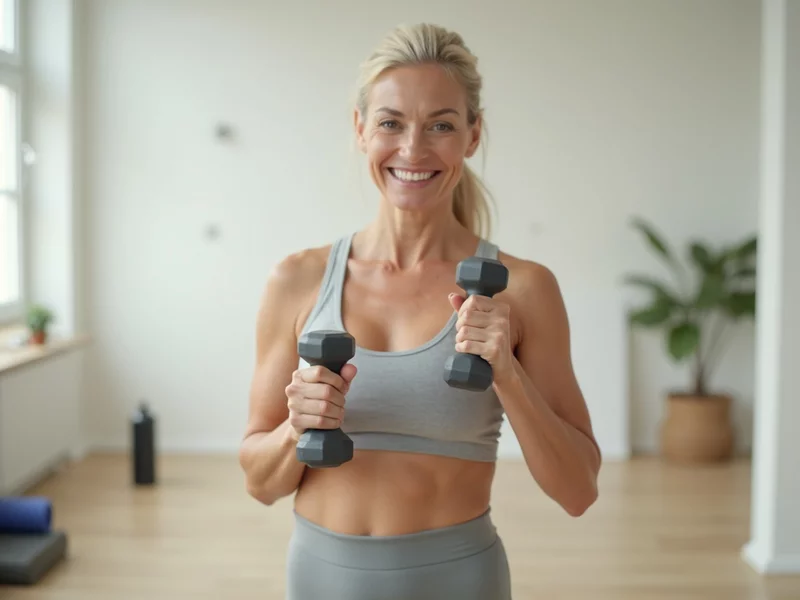Resistance Training for Bone Health

Every year, millions of women enter menopause, facing not just hormonal shifts but also significant impacts on their bone health. A staggering statistic reveals that up to 20% of bone density can be lost within just a few years of menopause. Understanding this connection is crucial for maintaining a vibrant and active life during this transformative phase.
What You Will Learn
- Menopause leads to a sharp decline in bone density due to decreased estrogen levels, making awareness of bone health essential.
- 1 in 3 women post-menopause will develop osteoporosis, increasing the risk of fractures and mobility issues.
- Trabecular bone is more vulnerable during menopause, emphasizing the need for targeted strength training.
- Resistance training is proven to significantly enhance bone mineral density and reduce the risk of fractures.
- Different types of resistance training (weightlifting, resistance bands, bodyweight exercises) offer unique benefits and should be incorporated into routines.
- Weight-bearing exercises such as walking, jogging, and dancing are vital for maintaining bone density during and after menopause.
- Research indicates that resistance training can be as effective as hormone replacement therapy in maintaining bone health without the associated risks.
- Low bone density is linked to serious health risks, including chronic pain and disability, making proactive health measures crucial.
- Functional benefits of resistance training extend beyond bone health, enhancing muscle mass, balance, and overall well-being.
- Community support and health initiatives play a significant role in promoting physical activity among aging women.
Key Insights on Menopause and Bone Density
Here’s a breakdown of the significant impacts of menopause on bone health and the benefits of resistance training for women navigating this stage of life. If you're curious about how other bodily changes during this time affect your overall wellness, consider exploring hormonal shifts and midlife activity.
Impact of Menopause
- Up to 20% of bone density can be lost in the first few years after menopause.
- Higher risk of osteoporosis develops due to estrogen loss.
- Awareness of bone health becomes essential during this phase.
Resistance Training Benefits
- Significantly increases bone density, especially in the hip and spine.
- Less bone loss compared to sedentary individuals.
- Combining resistance exercises with balance training yields greater benefits.
Types of Resistance Training
- Weightlifting: Highly effective for building strength.
- Resistance Bands: Great for low-impact workouts.
- Bodyweight Exercises: Include push-ups and squats.
Health Risks of Low Bone Density
- Osteoporosis increases likelihood of fractures.
- Fractures lead to mobility issues and decline in quality of life.
- Bone density loss can increase chronic pain risk.
Understanding the Connection Between Menopause and Bone Density
The Impact of Menopause on Bone Health
When we enter menopause, our bodies experience significant hormonal changes. Specifically, the drop in estrogen levels can lead to rapid bone loss, which can be alarming. In fact, many women can lose up to 20% of their bone density in the first few years after menopause!
This loss occurs because estrogen plays a crucial role in maintaining bone density. As the hormone levels decrease, the bone remodeling process shifts, leading to more bone being broken down than formed. It’s important to recognize these changes as they can set the stage for further complications down the road.
- Estrogen loss accelerates bone resorption.
- Higher risk of osteoporosis develops.
- Awareness of bone health becomes essential during this phase.
Why Bone Density Matters for Postmenopausal Women
Understanding the risks associated with low bone density is a crucial aspect of postmenopausal health. Women face a higher risk of developing osteoporosis, which can lead to frailty and increased chances of fractures. Imagine going about your day and then suffering a fracture from a minor fall—it’s a tough reality for many!
Many women think they’re safe if they haven’t experienced issues before, but the truth is, osteoporosis can develop silently. That's why it's vital to focus on enhancing bone health, especially as we age. At Empower Midlife Health, we advocate for proactive measures to keep our bones strong and resilient! For tips on managing other common symptoms, read about exercise for menopause symptom relief.
- Osteoporosis affects 1 in 3 women after menopause.
- Fractures can lead to long-term mobility issues.
- Preventive strategies are key to maintaining quality of life.
The Role of Trabecular and Cortical Bone in Postmenopausal Women
It’s essential to understand the differences between trabecular and cortical bone. Trabecular bone, found at the ends of long bones and inside the vertebrae, is more porous and responds quickly to changes in health. In contrast, cortical bone is dense, forming the outer layer of bones, providing strength and structure.
During menopause, trabecular bone is often affected first due to its sensitivity to hormonal changes. This can lead to a quicker decline in overall bone density. Strengthening both types of bone is important, and understanding their functions can guide us in choosing effective strategies for improving bone health.
- Trabecular bone is responsive to hormonal changes.
- Cortical bone provides structural support.
- Both types should be targeted in strength training.
The Role of Resistance Training in Enhancing Bone Density
How Resistance Training Benefits Bone Mineral Density (BMD)
Resistance training is a powerful ally in combating bone density loss. When we lift weights, our bones respond by becoming denser and stronger! This happens because the stress placed on bones during resistance exercises stimulates bone formation and preserves bone mineral density (BMD).
At Empower Midlife Health, I often tell my clients that every rep is like a love letter to their bones! Engaging in regular resistance training can create an environment where bone health thrives. It’s not just about lifting weights; it’s about lifting your overall well-being!
- Weight lifting leads to increased bone formation.
- Resistance training enhances overall strength.
- Improved BMD reduces fracture risk.
Comparing Resistance Training Types for Optimal Results
Not all resistance training is created equal! Different modalities offer varied benefits, making it essential to find what works best for you. Here’s a quick comparison of popular types:
- Weightlifting: Traditional and highly effective for building strength.
- Resistance Bands: Great for low-impact workouts, perfect for beginners!
- Bodyweight Exercises: Utilize your own weight—think push-ups and squats!
Each type can help improve bone density, but mixing them up can keep workouts engaging and provide a comprehensive approach to strength training. Remember, it’s about finding joy in movement, and every bit counts!
Incorporating Weight-Bearing Exercises for Bone Health
Weight-bearing exercises are essential for maintaining bone density, especially during and after menopause. These activities force you to work against gravity, which helps build strong bones. Activities like walking, jogging, and dancing can be both fun and beneficial!
Incorporating these exercises into your routine can create a solid foundation for bone health. Think of it as building a strong fortress—your bones deserve the best defenses against osteoporosis!
- Walking is an excellent choice for all fitness levels.
- Jogging increases heart health while building strong bones.
- Dancing adds a fun, social element to your workouts!
Pro Tip
Did you know? Incorporating just 30 minutes of resistance training three times a week can significantly improve your bone density and overall health. Try to include exercises that target both trabecular and cortical bones, such as squats and lunges, for maximum benefits!
Research Evidence on Resistance Training and Bone Density Improvements
Understanding the impact of resistance training on bone health is crucial for midlife women navigating menopause. Recent studies have highlighted the positive effects of strength training on bone mineral density (BMD), showcasing how regular exercise can make a substantial difference. At Empower Midlife Health, we believe that evidence-based practices empower women to take control of their health during this transformative phase. Here are some key findings from the latest research:
- Resistance training significantly increases bone density, particularly in the hip and spine.
- Women who engage in regular strength training experience less bone loss compared to sedentary individuals.
- Combining resistance exercises with balance training yields even greater benefits for overall bone health.
These findings not only validate the importance of physical activity but also provide a strong case for incorporating resistance training into your routine. It’s about reclaiming your strength and ensuring your bones are supported as you navigate this stage of life!
Comparative Analysis of Exercise Versus Hormone Therapy
When it comes to maintaining bone density, many women consider hormone replacement therapy (HRT). However, research shows that resistance training can be just as effective, if not more so, for some individuals. Here’s why strength training stands out:
- Resistance training builds not only bone density but also muscle mass, which contributes to overall physical stability.
- Unlike HRT, strength training has no risk of side effects and can be tailored to individual fitness levels.
- Exercise enhances overall mood and mental health, providing holistic benefits during menopause.
As a coach at Empower Midlife Health, I often emphasize that movement is a powerful ally. Not only does it strengthen your bones, but it also uplifts your spirit!
Health Risks Associated with Bone Density Loss
Low bone density can lead to serious health concerns, including osteoporosis and increased risk of fractures. Understanding these risks is vital for motivating action towards proactive health measures. Here are some critical health risks associated with declining bone density:
- Osteoporosis increases the likelihood of fractures, particularly in the hip, wrist, and spine.
- Fractures can lead to mobility issues and a decline in overall quality of life.
- Bone density loss can increase the risk of chronic pain and disability.
It’s clear that maintaining bone health is essential for a vibrant midlife experience. At Empower Midlife Health, my goal is to equip women with the knowledge and strategies to combat these risks head-on! To further understand the connection between physical activity and well-being, explore the benefits of exercise for menopause symptom relief.
Functional Benefits of Resistance Training Beyond Bone Density
Resistance training is not just about building stronger bones; it offers a wealth of functional benefits that enhance overall health and well-being. As we age, maintaining muscle mass and balance becomes increasingly important. Here’s how strength training contributes to functional fitness:
- Increased muscle mass enhances metabolism and overall strength.
- Improved balance and coordination reduces the likelihood of falls.
- Enhanced physical fitness boosts confidence and encourages an active lifestyle.
Incorporating resistance training into your routine not only protects your bones but also fosters independence and vitality as you navigate this exciting chapter of life!
Testimonials and Case Studies from Postmenopausal Women
Real-life experiences can be incredibly motivating! Many women who have embraced resistance training share transformative stories of strength and resilience. Here are a few inspiring testimonials:
- "Since starting strength training, I've not only seen improvements in my bone density but also feel more energetic and confident!"
- "The community support from Empower Midlife Health has made a world of difference in my journey to better health."
- "I never thought I could lift weights, but now it’s a highlight of my week!"
These stories illustrate the incredible empowerment that comes from engaging in resistance training. It’s more than just exercise; it’s about connecting with other women and celebrating our strength!
Community Health Initiatives Promoting Physical Activity
At Empower Midlife Health, we are passionate about promoting community health initiatives that encourage physical activity among aging women. Local programs play a critical role in motivating individuals to get moving. Here’s how communities are making a difference:
- Offering group fitness classes tailored for midlife women.
- Creating walking and exercise clubs that foster social connections.
- Providing resources and workshops on the importance of resistance training and overall wellness.
By being part of a supportive community, women can find encouragement and companionship on their health journey. Together, we can inspire each other to embrace movement and strength!
Summing Up the Importance of Resistance Training for Bone Health
As we draw to a close, it’s essential to recognize the long-term benefits of incorporating resistance training into your wellness routine. Not only does it support bone health, but it also enhances overall functional fitness and well-being. Remember, every little step counts!
Long-Term Benefits of Resistance Training for Menopausal Women
Incorporating resistance training is a powerful strategy for postmenopausal women. Here’s a recap of its benefits:
- Strengthens bones and muscles, reducing the risk of osteoporosis.
- Enhances balance and coordination, lowering the risk of falls.
- Boosts confidence and encourages an active lifestyle.
Let’s celebrate our strength and resilience during this journey!
Encouraging Action: Start Your Resistance Training Journey Today
If you’re ready to take the first step towards better bone health, I encourage you to consult with health professionals and explore resistance training options that suit your needs. Remember, it’s never too late to start moving! Together, let’s empower each other to embrace this journey of strength, health, and vitality. For additional support and guidance on navigating this life stage, consider resources on menopause and women's health.
Recap of Key Points
Here is a quick recap of the important points discussed in the article:
- Menopause leads to decreased estrogen levels, resulting in rapid bone loss and increased risk of osteoporosis.
- Understanding the types of bone—trabecular and cortical—is crucial for effective bone health strategies.
- Resistance training significantly enhances bone mineral density (BMD) and reduces the risk of fractures.
- Incorporating various forms of resistance training, such as weightlifting, resistance bands, and bodyweight exercises, can improve bone health.
- Weight-bearing exercises, like walking and jogging, are essential for maintaining bone density.
- Community support and health initiatives play a vital role in promoting physical activity among postmenopausal women.
- Long-term benefits of resistance training include stronger bones, improved balance, and enhanced overall well-being.
Frequently Asked Questions About Menopause and Bone Health
- Q: How much bone density can be lost during menopause?
- A: Up to 20% of bone density can be lost within just a few years after menopause due to declining estrogen levels.
- Q: What is osteoporosis and why is it a concern for postmenopausal women?
- A: Osteoporosis is a condition where bones become brittle and fragile. It's a concern for postmenopausal women because 1 in 3 women will develop it, significantly increasing the risk of fractures and mobility issues due to estrogen loss.
- Q: How does resistance training help with bone density?
- A: Resistance training stimulates bone formation and preserves bone mineral density (BMD) by placing stress on the bones, making them denser and stronger.
- Q: What types of resistance training are effective for bone health?
- A: Effective types include weightlifting, resistance band exercises, and bodyweight exercises (like push-ups and squats). Mixing these can provide comprehensive benefits.
- Q: Are weight-bearing exercises important for bone health?
- A: Yes, weight-bearing exercises like walking, jogging, and dancing are vital as they force your body to work against gravity, which helps build strong bones.
- Q: Can resistance training replace hormone replacement therapy (HRT) for bone health?
- A: Research suggests that resistance training can be as effective as, or even more effective than, HRT for some individuals in maintaining bone density, without the associated risks of HRT. It also builds muscle mass and improves mental health.
- Q: What are the functional benefits of resistance training beyond bone density?
- A: Beyond bone density, resistance training increases muscle mass, improves balance and coordination (reducing fall risk), enhances physical fitness, boosts confidence, and promotes overall well-being.
Popular Posts
 As women navigate through menopause, they often face significant changes physically and emotionally.
As women navigate through menopause, they often face significant changes physically and emotionally.
 Menopause can be a daunting phase in a woman's life, often accompanied by significant physical and e
Menopause can be a daunting phase in a woman's life, often accompanied by significant physical and e
 What if the key to thriving in midlife lies in something as simple as lifting weights? Resistance tr
What if the key to thriving in midlife lies in something as simple as lifting weights? Resistance tr
 Did you know that understanding your hormones can significantly enhance your exercise performance? A
Did you know that understanding your hormones can significantly enhance your exercise performance? A
